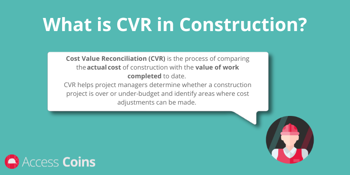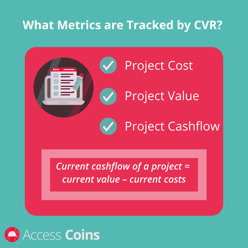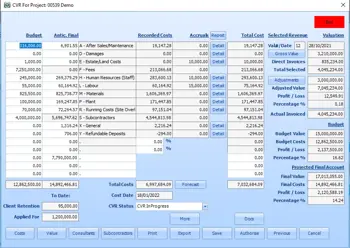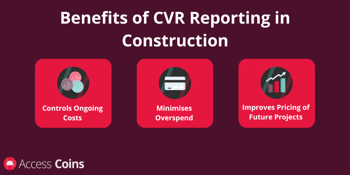What Is Cost Value Reconciliation (CVR) In Construction?
Cost Value Reconciliation (CVR) is the process of comparing the actual cost of construction with the value of work completed to date. CVR helps project managers determine whether a construction project is over or under-budget and identify any areas where cost adjustments need to be made.
Put simply, the CVR process involves analysing the work completed on a construction project, comparing it with the budget and identifying any discrepancies.
This guide covers what is CVR in construction, why it’s important and how CVR reporting can be automated using Access Coins, our construction-specific platform.

Why is Cost Value Reconciliation (CVR) Important in Construction?
Cost value reconciliation (CVR) is an essential process in the construction industry because it helps ensure that a construction project is completed on-time, on budget and within expected profit margins.
CVR allows construction contractors to periodically assess the progress of their projects and ensure that they are not over or under-spending. It also helps to identify any potential risks that could lead to cost overruns, rework and delays.
Profit margins within the construction industry are razor-thin, and CVR is essential to maintaining those margins – and identifying costly elements of a project.
By regularly generating CVR reports, construction contractors can ensure that they are delivering projects in the most cost-effective and efficient way possible while maintaining transparency with clients.
"Cost Value Reconciliation (CVR) is a strategic safeguard for construction businesses. Project variables can shift daily, and CVR enables proactive decision-making rather than reactive firefighting.”
Stuart Clews, Head of Sales, Access Construction

What Metrics are Tracked by CVR?
The 3 key metrics a CVR report must include are:
- The cost of a construction project
- The value of a construction project
- The cashflow of the project
The Costs Of A Construction Project
Cost is an integral element of CVR. A CVR compares the cost of work to the actual value of the work delivered within the project-to-date.
Costs include direct and indirect costs, including labour, materials, overheads and subcontractor costs.
The Value Of A Construction Project
The value of the project is the value of all the work completed to the current date. This can include work certified and work not certified. Work certified includes all work that has been not only completed, but also inspected and approved by the project owner or client.
The Cashflow of a Construction Project
Current cashflow of a project = current value – current costs
When reviewing the cost and value of a construction project, managers can understand the health of the cashflow for the project.
A CVR report can also track a range of different construction project metrics such as:
- Resource utilisation
- Project quality
- Customer satisfaction
- Project timelines

Automate Accurate CVR Reporting With Access Coins
Automatically calculate and update CVR and produce CVR reports at the click of a button with Access Coins, the ERP built for construction.
How is CVR carried out in Construction?
Here is a step-by-step guide to the CVR process -
1. Gather Project Data
Collect all relevant cost and value data for the reporting period (usually monthly).
Sources include purchase orders, subcontractor accounts, labour costs, plant hire and invoices.
2. Review Budget & Original Allowances
Compare actual costs against the original forecasted budget or tender allowances.
Ensure any variations or changes are accounted for.
3. Record Actual Costs
Input all incurred costs to date into the cost ledger.
Include committed costs (e.g., approved orders not yet invoiced).
4. Assess Work in Progress (WIP)
Measure the value of work completed on-site.
Use site progress reports, valuations, or quantity surveyor assessments.
5. Calculate Earned Value
Determine the value of work done (based on contract rates or agreed valuations).
This is the “value” side of the reconciliation.
6. Compare Cost vs. Value
Reconcile actual costs incurred against the value of work completed.
If the actual costs are higher than the original budget, project managers need to identify the reasons for the cost increase and take corrective measures, such as reducing costs or increasing efficiency.
If the actual costs are lower than the original budget, project managers need to identify the reasons for the cost savings and determine how to allocate the savings.
7. Forecast Final Costs & Value
Update cost-to-complete forecasts.
Adjust for anticipated variations, risks and opportunities.
8. Prepare CVR Report
This report typically includes -
- Original budget vs. actual costs
- Value of work done
- Current margin and projected final margin
- Highlighted problem areas and suggested corrective actions.
9. Review & Approve
Present CVR to project manager, commercial manager, or board for review.
Use findings to inform financial reporting and decision-making
Use Case: CVR in Action on a Commercial Build
Project Overview:
A commercial contractor is delivering a £12 million office development in Manchester. The project is scheduled for 18 months, with tight margins and a fixed-price contract.
Challenge:
By month 6, the project manager notices discrepancies between projected and actual costs. Material prices have surged due to supply chain issues, and subcontractor overtime is increasing labour costs. Without a clear view of financial performance, the team risks overspending and missing profit targets.
CVR Implementation:
The finance team decides to run a monthly CVR report that pulls real-time data from their procurement, labour and project management systems. The report highlights:
- A £250,000 variance in steel procurement due to price inflation.
- Labour costs trending 12% above forecast due to weekend shifts.
- Underspend on scaffolding due to early completion of structural work.
Outcome:
With this insight, the project manager renegotiates supplier contracts, adjusts labour scheduling, and reallocates budget from scaffolding to cover steel costs. By month 9, the project is back on budget trajectory and the finance team uses the CVR data to inform pricing on a new tender.

What are the Pros and Cons of Cost Value Reconciliation (CVR?)
Pros of CVR
Controls Ongoing Costs
Particularly over the last few years there has been a huge amount of worldwide disruption which has seen large increases in material costs, energy costs and labour costs . Keeping control of ongoing costs has never been more important to construction companies. CVR ensures ongoing costs can be tracked and monitored closely to ensure the construction project stays on course.
Minimises Overspend
CVR reports are traditionally produced on a monthly basis throughout a construction project. This regularity means that costs are frequently reviewed, and any required adjustments/actions are put in place to ensure that overspend is less likely at the end of projects.
Helps Construction Firms Price Future Projects Accurately
Because CVR is a documented/recorded process, construction companies are able to use previously produced CVR reports as guidance on how to correctly cost future construction projects. CVRs are great for understanding previous mistakes and improving cost evaluations for the future.
Cons of CVR
Human Error Can Lead To Miscalculation
Many construction companies build their CVR reports in Microsoft Excel, which relies on manual data entry, which in turn increases the risk of human error in the process. These errors can lead to miscalculations and incorrect costings later down the line with final reports.
To reduce this risk, construction companies are use software such as ERP (enterprise resource planning) to automatically collect and calculate financial data across a range of sources.
CVR Needs Resources
In most construction companies, a member of the finance team has the responsibility for CVR reporting. This involves gathering required information from multiple teams, inputting data, generating and editing reports and circulating regular reports to the relevant stakeholders.
It goes without saying that CVRs require a lot of work, diligence and resource to get the most out of them.
The good news is there are solutions out there to simplify the CVR reporting process – learn more about our construction financial software, with features built to help automate CVR calculation and reporting.

Automate CVR Reporting with Access Coins
Access Coins, our powerful construction management software, includes a module devoted to calculating and reporting CVR which cuts days of work from the CVR reporting process.
Say goodbye to manual reconciliations. The Access CVR module pulls live data straight from your centralised Access Coins database, giving you fast, accurate cost-value insights without the hassle.
Generate flexible CVR reports on demand, complete with a full audit trail, while still giving surveyors the freedom to make adjustments when needed. Review results instantly via interactive dashboards or export in multiple formats.
“What sets Access Coins apart is how it automates and simplifies the CVR process. Our CVR module pulls live data from across the platform, giving contractors instant visibility into cost performance, cashflow and risk - without the manual effort. That’s a huge advantage in today’s construction environment.”
Stuart Clews, Head of Sales, Access Construction
More construction software information, guidance and advice

UK Construction Industry Trends: 2025 Report
Go to article
What Is Job Costing In Construction?
Go to article
Creating A Bill Of Quantities On Excel – How Easy Is It?
Go to article
Benefits of Using ERP In The Construction Industry – Reviewing The Pros and Cons Of An ERP System
Go to article

 AU & NZ
AU & NZ
 SG
SG
 MY
MY
 US
US
 IE
IE

